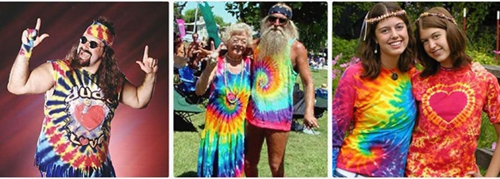Western-born Hippies wear a passion for Chinese Tie-dye T-shirts
By Jianyu Hou Freelancer based in Cleveland, OH., USA
During the 2008 Beijing Olympic Games, I bought a crimson background tie-dye dress from the Beijing Zoo Clothing Wholesale Market. The colorful whirls on the fabric looked like passionate burning flames with different spectrums of halos around them.

A scene of happy dancing Bai people surrounding a bonfire emerged in my mind. Believing that it would bring a good mood and luck, I was later proven right after purchasing it.
In the following years, I still wear this tie-dye dress every summer, both in China and the United States of America. The sunshine and liquid soap and time have barely worn the colors and fabric. Many passers-by said they loved the tie-dye pattern.
Apparently, Westerners are more enthusiastic about tie-dye than the Chinese are. A tie-dye dress is like a magic tool to help start new conversations with Western people, which triggered me to find the story of tie-dye in the US.
Tie-dye is a traditional Chinese dying technique used by the Bai people, a minority ethnic group residing in Yunnan Province, Southwest China. They fold the fabric with hemp and submerge it into natural pigments. After unfolding the fabric; beautiful patterns emerge.
There are patterns of the tie-dye look, such as the visual effects of digital music players. For some primitive religious rituals, the hallucination, which believers experience when they go into ecstasies, are images just like the patterns of tie-dye.
Nature, mystery and exoticism, all these features make tie-dye gain universal popularity. In 2006 and 2008,China's Ministry of Culture added the tie-dye technique of the Bai people, Dali, Yunnan Province and the tie-dye technique of Zigong, Sichuan Province to the list of National-level Intangible Cultural Heritage.
In China, the popularity of tie-dye reached its peak during the Tang Dynasty (618-907 A.D.). The rulers of the North Song (960-1127 A.D.) banned the tie-dye industry, because it wasted too much money and labor, but the tie-dye technique has been preserved in Southwest China, spreading to South Asian countries as well.
In the US, if you go to big cities, in some hippie areas, you may see many tie-dye clothes available in music stores, tobacco stores, on display with vinyl records, sunglasses, tobacco pipes, decorations of oriental religions, and other stuff popular gadgets for hippies.
It was during the Hippie Movement that the tie-dye folding and dying technique was introduced from China to the US. Long wigs, tie-dye shirts or skirts, fringed vests, peace signs, and sunglasses were typical accessories for hippies in the 1960s.
Hippies believed that everything should have its alternative, and they have borrowed many alternatives from the East, such as oriental religions, dietary customs, Traditional Chinese Medicine. Tie-dye was the alternative for dressing.
Compared with stiff and formal suits, the symbol of a traditional lifestyle and path uncritically accepted by their parents, the rebellious hippies chose tie-dye clothes to represent their values.
Wild patterns, combinations of colors with strong contrasts, casual designs, and the soft and comfortable touch of the fabric, all these elements have created a genuine manifestation of the spirit of the Hippie Movement— an awakening and freedom from conformity.
Nowadays, many American families make tie-dye clothes in their own bathtubs. This technique can transform old white T-shirts into new ones. In this country of individualism, customizing ones' tie-dye clothes make people look more unique.
A home-made tie-dye dress is the right fit for a summer backyard party, accompanied with fresh beer, music and dancing.
Many tie-dye fans make their Journey to the East to get the Canon of Tie-dye Technique. Dali, where tie-dye's hometown Zhoucheng, which is reputed to be a "Hippie Paradise," is attracting throngs of travelers each year. So to feel authentic tie-dye artworks, please go to Dali.
If you're going to Dali, China, Be sure to wear some tie-dye clothes there. If you're going to Dali, China, You're gonna meet some gentle people there. ——Adapted from San Francisco - Scott McKenzie
(This article was first published on Panview Channel, CCTV.com)
( The opinions expressed here do not necessarily reflect the opinions of Panview or CCTV.com. )
